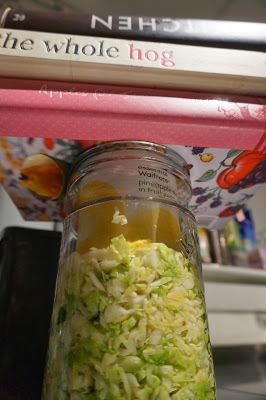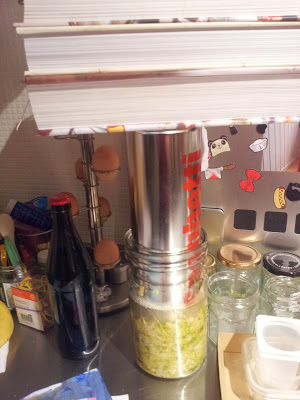Local (& Late!) Random Recipes #33
Anyway enough of the excuses and percentages - this is supposed to be a blog about making stuff, dubious maths. I'd better get on with the food bit, since there's a salutary lesson about precariously balancing things to finish off the post with!
| A shot that belies the disaster that lies ahead...! |
I've got a couple of Polish cook books, and I figured they would be a good source of cabbage recipes, and so, I found myself embarking on making my own Sauerkraut, from page 98 of "Treasured Polish Recipes for Americans". I can't help feeling I'm breaking some rules by being Scottish and cooking from it... maybe that's why it all ended in disaster - cookbook karma!
I reduced the quantities a bit - quite thankfully I didn't have 5lb of cabbage to deal with, so here's my version.
Homemade Sauerkraut
- 1 large head of green cabbage
- 1.5 tbsp sea salt
- 1/2 tsp caraway seeds (I love caraway - reduce or omit if you're not such a fan)
| Shredded |
Once you've finished your tea, return to your big bowl of cabbage and get your hands in and start crunching the cabbage up in the salt. It will fairly quickly change consistency and stop being hard and crunch as the salt starts to draw the liquid out of the cabbage.
| After salt smushing |
Pack into a clean glass jar or plastic tub and weight it down well. (I'll come on to this in my salutary tale shortly....).
The cabbage will begin to ferment and release liquid - you want your weights to keep the cabbage below the top of the brine.
 |
| Tin of pineapples and books - precarious but crucially stable. I should have stopped at this! |
Once you've finished the fermentation, store in an airtight tub in the fridge, and it should last a good few weeks.
However.... I can't tell you how it worked out, because mid-way through the fermentation process, there was a disaster - a 'kraut catastrophe indeed, largely due to my Heath Robinson style of weighting. Turns out that balancing 4 heavy cookbooks on on top of a spaghetti canister sitting on top of the cabbage isn't such a good idea. Who'd have thought it?! In fact I'd strongly recommend trying anything but this method - because what I ended up with was not sauerkraut, but instead a kitchen carpet covered in fermented cabbage juice and shards of glass. Cleaning it up was really not a fun job!
 |
| Weight your sauerkraut down like this.... |



